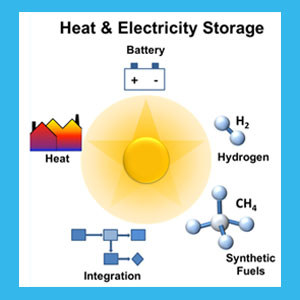Speaker
Dr
Guenter Schmid
(Siemens AG, CT NTF COS)
Description
The enlargement of the feed-in capacity of volatile renewable electricity into the grid implies the necessity to convert this energy into storable materials during times, where the excess of energy cannot be consumed by the net. The Power-To-Gas or SolarFuel concept stores the excess energy in i.e. methane, which could be eventually back converted into electricity on demand. Such seasonal, large scale concepts are very reasonable from the energetic and ecological point of view. However, it is very hard to obtain economic feasibility when considering the low fossil energy carrier prices and the physical efficiency limitations of the processes.
Power-to-Value targets to maximize the ecological and economical benefit with respect to the available excess energy. Therefore its scaling is limited only by the stage of expansion of the absolute amount and proportion of solar and/or wind energy in the grid mix. Power-to-Value unifies energy storage, emission reduction, chemical feedstock and economic feasibility. The price of most chemical compounds is much higher when compared to its energy content.
In the presentation, two potential approaches are discussed.
1. Direct electrochemical reduction of CO2 towards chemical feedstock
The current emission of CO2 from power plants is an almost inexhaustible carbon source. Depending on the electro catalytic system, CO2 can be electrochemically reduced to carbon monoxide (CO), methane (CH4), ethylene (C2H4) and various other hydrocarbons even in aqueous media. CO and C2H4 are valuable feedstock for the chemical industry with a coincident high yearly sales volume. CO could be obtained with faradic efficiencies over 90% at current densities exceeding the industrial necessary level of 100 mA/cm² with a total energy efficiency approaching 50%. Ethylene is more challenging due the highly complex reduction process involving 12 electrons and 8 protons. Faradic efficiencies up to 40% for ethylene could be obtained using structured copper based electrodes.
2. Energy storage and discharge using alkaline or earth alkaline metals
(Earth) alkaline metals are intrinsically high density energy storage materials due to their electrochemical potential. The production of these metals is well established using electrolysis and could, therefore be quickly scaled up. The question arises, how to discharge this energy carrier delivering energy and simultaneously producing high value chemicals. (Earth) alkaline metals can even be burned in atmospheres such as CO2, H2O and N2 yielding products such as CO, H2 or nitrides. The temperature of the combustion is high enough to drive ordinary steam power plants. The nitrides can exothermally be hydrolyzed to the fertilizer ammonia (NH3). We have built a 30 kW burner, which burns molten Lithium in the various atmospheres. The presence of all desired products could be confirmed by chemical analysis.
Author
Dr
Guenter Schmid
(Siemens AG, CT NTF COS)

